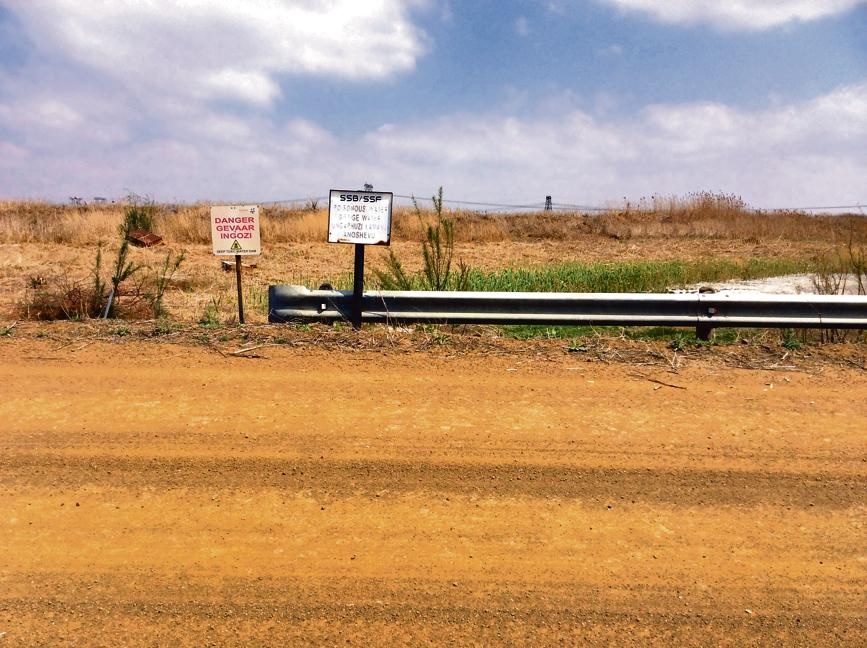Sometime in September 2014, two water troughs mysteriously appeared on the farm in Secunda where Chris Skosana grazes his cattle. He later discovered that the troughs were a gift from his neighbour, multinational chemical giant Sasol. But Skosana, a part-time farmer and father of six, was unimpressed.
In court papers filed in the North Gauteng High Court last week, he claims the fresh water troughs were only installed by Sasol after it accidentally discharged “highly toxic and polluted water” on to his grazing land.
Since 2009, Skosana has suffered devastating losses to his herd of cattle.
“I was trying by all means to save that cattle by buying the medicine, injections – all that stuff,” he said.
Skosana claims to have lost 50 head of cattle over five years, leaving him with 62 animals.
Two months after the troughs appeared, he received a letter from Derick Erasmus, one of the owners of the land, telling him that he needed to move his cattle.
“Regrettably, the drinking water on our farm premises has been contaminated through the actions of Sasol,” the letter reads. “We have received a report from Sasol that discloses that the drinking water at our farm premises is no longer fit for human or animal consumption.”
The report, commissioned by Sasol, found that “the water quality of the two dams renders them unsuitable for livestock watering” and the “water poses a risk to the health of the cattle”.
“I thought, oh, that’s the reason my cattle are dying. Because all the time I didn’t have any problem with this place, but after that pollution [started], then the cattle started dying,” said Skosana.
In his affidavit, he said that since Sasol started supplying fresh water to his cattle, none had died.
Skosana approached the court last Monday after Sasol’s lawyers threatened to cut the fresh water supply to his cattle at the end of this month. Last Wednesday, Sasol agreed not to cut the supply.
“The urgent interdict application brought by Mr Skosana against Sasol was withdrawn by him,” said Sasol spokesperson Alex Anderson last Friday, adding that although Sasol was not legally obliged to supply the water, it would continue to do so.
R150 million in damages
Skosana’s David-and-Goliath battle with Sasol is only a small part of a much bigger court case between Sasol and Templemore Trading 69, which owns the land.
In November last year, Templemore, represented by senior counsel Kemp J Kemp, issued a summons against Sasol demanding R150 million in damages, this being the profits it claims it could have made from developing the land into an industrial park.
Templemore first confronted Sasol about water pollution in June 2014 after finding a suspicious white residue on the property.
It was only then that Sasol admitted that, six months earlier, in December 2013, a crack had developed in one of the pollution dams, known as Fine Ash Dam 4. To prevent the dam from collapsing, Sasol was forced to release contaminated water into the water system that runs along Templemore’s western boundary and into the local Kleinspruit River.
Some of this contaminated water, it conceded, had flooded on to the farm and into two small dams, from which Skosana’s cattle usually drank.
Toxic water
A narrow dirt road and a mesh fence separate Skosana’s cattle from this series of water canals and pollution dams on Sasol’s property.
At regular intervals along the fence, signs warn: “POISONOUS WATER”, “DANGER: DEEP TOXIC WATER DAM” and “WATER AND VEGETATION NOT SUITABLE FOR HUMAN CONSUMPTION”.
Anderson said these signs were merely a “precautionary and risk control measure” that Sasol was legally required to display, but that there was “clear evidence of aquatic life in these dams”.
Test results from 2011 and 2013 indicate that the water in these dams had at various times contained levels of selenium, molybdenum, sulphates and fluoride that were high enough to cause bloody diarrhoea and dehydration in large animals and people.
Anderson said that despite the first report finding that the water was not safe, Sasol commissioned a second report from a “specialist toxicologist”, which found that “cattle could safely have consumed this water”. City Press asked for a copy of this report, but the request was declined for “legal reasons”.
A bigger problem
However, both Templemore and Skosana maintain that the widespread pollution on the property is not from the one leak in December 2013, but due to an ongoing problem of chemicals leaking from the ash dams and dump sites on Sasol’s property.
Laboratory tests of water and soil samples collected from different parts of the farm show elevated levels of a wide range of metals, including mercury, copper, manganese, vanadium and lead.
In court papers, Templemore claims that “the level of harmful and poisonous substances ... has steadily increased with the passing of time”, turning the small cattle dam “from a blue colour to having a pink tinge with serious and toxic crystallisation occurring at the edges of the dam”.
Templemore alleges this contamination can also be attributed to Sasol – a claim Sasol said it intended to fight in court.
Sasol’s 2009 waste permit allows it to dump 47 877 tons of waste, including ash, coal, sludge and contaminated soil, on to the fine ash dams every day. It is also allowed to dump another 8 820 tons of more toxic waste into a black products area 1.5km away every day, including catalysts, tar, flammable material and sulphur-contaminated waste.
Because these dams were built many years ago, they are not lined. Anderson said the dams were “underlayed with clay soils”, which limited the amount of water leaking from them.
Templemore has taken photos that appear to show water seeping from the dams on to the farm.
When asked about these photographs, Anderson said: “They were taken after heavy rainfall ... Sasol has inspected the areas ... during the winter, at which time there was no evidence of water. This confirmed that the water in the photos was rainwater and not water that seeped from Sasol’s dams.”
When City Press pointed out that the photos in question were taken in June, when Secunda experiences on average just 1mm of rain for the entire month, Anderson said they could not comment further because of the legal proceedings.
Is pollution in your area affecting your health?
SMS us on 35697 using the keyword SASOL and tell us what you think. Please include your name and province. SMSes cost R1.50




 Publications
Publications
 Partners
Partners














